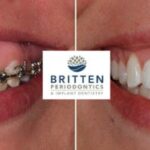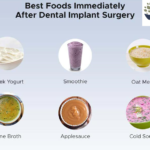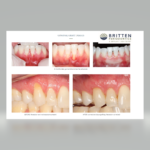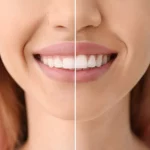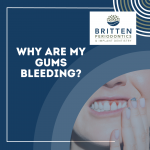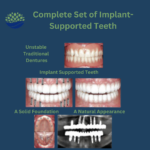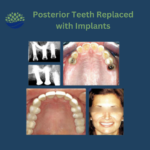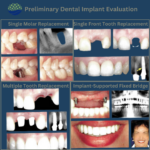- Point the gum stimulator toward your gums at a 45 degree angle.
- Run the rubber tip of the gum stimulator in a circle for 10 seconds between each tooth. Stimulate the gums by working the rubber tip back and forth along the gum line. Besides removing plaque, it stimulates your gums and helps with blood circulation.
About Britten
- Email:
- Nice Name: britten
- Website:
- Registered On :2016-02-09 00:55:27
- Logged in as: Britten
Britten Posts
Case Study: Clinical Crown Lengthening
Clinical Crown Lengthening is designed to expose more tooth structure prior to restorative and cosmetic dentistry and/or to improve the esthetics of your gum line. A frequently asked question is whether we can change the esthetics of a gummy smile because the teeth appear somewhat short. Your teeth can actually be of proper length and just covered with excessive gum tissue. In such circumstances, a crown lengthening procedure will correct this by exposing the shape of your natural teeth.
Crown lengthening can also be done to single teeth to “even out” your gum line and create a more symmetrical smile.
If your teeth are decayed, fractured at or below the gum line or have insufficient tooth structure for new crown retention, a “Clinical crown lengthening” procedure may be recommended by Dr. Britten to enable your general dentist to perform a restorative and/or cosmetic dental procedure.
Single Dental Implant
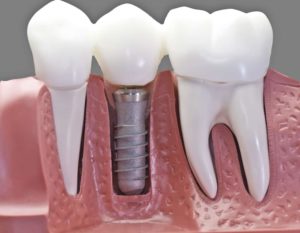
- Superior To A Traditional Bridge
- Natural Look And Feel
- Ability To Last A Lifetime
Multiple Dental Implants
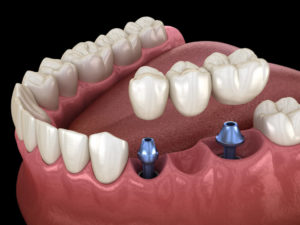
- Bridge Attached To Implants
- Natural Look And Feel
- 98% Chewing Ability Restored
Implant-Supported Denture
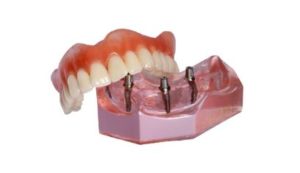
- High Quality Custom Denture
- Secured By 2-4 Implants
- Snaps In & Out
Traditional Acrylic Denture
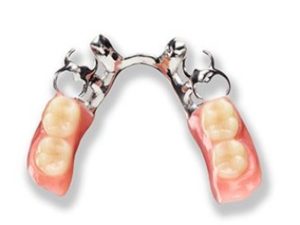
- Natural Look & Feel
- Lower Cost Fixed Option
- Leave with Teeth Same Day Of Surgery
Hybrid Teeth
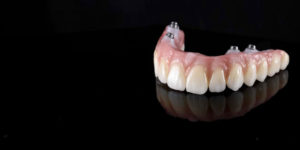
- Strong, Rigid Metal Bonded To Resilient Hybrid
- Highly Polishable, Beautiful Aesthetic
- Very Durable, Lightweight
Zirconia
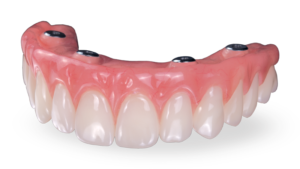
- The Greatest Combination Of Strength And Cosmetics
- Closest To The Feel Of Your Natural Teeth
- Most Durable & Long-Lasting
After a dental implant surgery patients should stick to the following diet recommendations for a good recovery. It’s important to avoid any foods that may physically disrupt the implant or cause discomfort.
- The first thing to take under consideration is the importance of not skipping meals, getting the nutrition your body needs is key to gaining strength, feeling better and faster. If you have a special diet requirement related to a medical condition, like for example being a diabetic, you should keep those eating habits or follow instructions that your specialist prescribe.
- It is best to start from soft and liquid food to then progress into solids over a few days. Keeping hydrated is key. While some doctors advise to stick only with liquids or pureed foods like ice cream, soups, puddings, yogurt, milk shakes, for the first few days, that it’s not a requirement.
- On the day of the surgery drinking plenty of fluids (up to 2 quarts of liquid per day) and avoiding hot liquids or hot food because they will promote bleeding and swelling.
- Extremely hot food is also something to stay away from and patients shouldn’t use a straw for the first few days after surgery.
- Avoiding drinking any alcoholic beverages
- Avoid smoking
Comfort is very important at this point, eating should not be a painful experience for the patient, so choosing the right food can vary from one person to the other but general rules still apply. Recovering patients should avoid chewing food until tongue sensation has returned and also stay away from food that may get lodged in the surgical areas like popcorn, rice, sunflower seeds, nuts etc.
Here is a list with a few examples that can help you
- Softer fruits, such as bananas, peaches, nectarines, melons, and all berries are usually good choices
- Avoid hard food: Go for oatmeal and soft cereals, soft bread, rice, grits, or mashed potatoes.
- More water: Staying hydrated is vital to your immune system and overall health, and nothing will keep you hydrated more efficiently than water.
- Fruits and vegetables: Remember to cut them into small pieces first.
- When it comes to vegetables, cooked or steamed vegetables are better like broccoli, carrots, and squash.
- Sauces and soups are the best way to go. Softer fruits like bananas, peaches, nectarines, melons, and all berries are good as well.
- Protein: eggs, fish and seafood, and beans are safe, and also dairy products such as milk, yogurt, and cheese. Other alternatives include couscous and quinoa, while being a wheat and grain.
More ideas for a speedy recovery:
- Macaroni and cheese, soft bread, baked or mashed potatoes.
- Scrambled eggs, cottage cheese, applesauce.
- Ground beef, baked or broiled fish, broiled or stewed chicken (finely chopped).
- Cooked cereals, such as oatmeal or cream of wheat, yogurt.
- Juice, water, milk, coffee, tea.
- Puddings, pound cake, milkshakes, ice cream.
- Home cooked broth, bouillon, soups.
Gum grafting is a common periodontal procedure. This common procedure is performed with excellent results. Some of the major benefits associated with gum grafting include:
- Reduced sensitivity – When a tooth root becomes exposed, eating or drinking hot or cold foods can cause extreme sensitivity to the teeth. Gum grafting surgery can permanently cover the exposed root, help reduce discomfort, and restore the good health of the gums.
-
Improved appearance – Periodontal disease is characterized by gum recession and inflammation. Gum recession and root exposure can make the teeth look longer than normal and the smile to appear “toothy.” Gum grafting can make the teeth look shorter, more symmetrical and generally more pleasing to look at. In addition, adjacent tissue can be enhanced and augmented during the procedure for aesthetic purposes.
-
Improved gum and tooth health – Periodontal disease can progress and destroy gum tissue very rapidly. Gum grafting can help halt tissue and bone loss; preventing further problems and protecting exposed roots from decay.
Dr. Britten has trained in the latest minimally invasive techniques of gum grafting and can often perform the entire procedure through a pinhole incision.
Implant Planning: What to Know About CBCT Scans
At Britten Periodontics & Implant Dentistry, we use 3D low radiation Cone Beam CT Scans for diagnosis and treatment planning. While it only take less than a minute, the scan supports a much higher level of patient care compare to conventional 2D X-ray films. 3D low radiation Cone Beam CT Scans allow a detailed look at existing teeth, bone, nerves, and tissue.
The 3D Cone Beam CT Scan provides three-dimensional and cross-sectional views that allow Dr. Britten to:
- Examine the quality and density of the bone that will anchor the dental implant
- Determine the proper treatment approach for each individual patient
- Determine the precise placement of implants
- Select the correct type and size of the implants
- Avoid the nerves and sinuses.
Dr. Britten uses the best materials for implants, employing state-of-the art technology and procedures. His commitment to quality implant care has gained the confidence and earned the trust of many of patients just like you.
Proper Home Care
Power toothbrushes, especially Philips Sonicare (Bestsellers | Philips) brushes, are our #1 recommendation for our patients. They are easy to use and can remove plaque more efficiently than a manual toothbrush. Simply place the bristles of the electric brush on your gums and teeth and allow the brush to do its job holding it for at least 5 seconds on one or two teeth at a time.
Toothbrushing – Brush your teeth at least twice a day (especially before going to bed at night) with an ADA approved soft bristle brush and toothpaste.
-
When using a Sonicare, place the brush at a 45 degree angle, ensuring that you always feel the bristles on the gums.
-
Brush the outer, inner, and biting surfaces of each tooth.
-
Use the tip of the brush to clean the inside of the front teeth.
-
Brush your tongue to remove bacteria and freshen your breath.
Clean Between Your Teeth at least 1-2 x a day With Proxabrushes, Softpicks and/or floss:
Softpicks and interdental brushes (also known as proxabrushes) are available in many sizes and are gaining in popularity because they are easy to use, and for some patients – more effective than flossing alone!
Proxabrushes – Proxabrushes are available on handles (similar to length of toothbrush handles) or in travel sizes. A travel proxabrush is covered by a cap that sheaths over the brush. This form of Proxabrush is conveniently kept in ones pocket or purse, and thus is good for those individuals who want to clean between their teeth during the day, or to take to restaurants or trips.
Who Should Use Them?
- Anyone who finds flossing difficult
- People who don’t like to floss
- People with exposed roots
- Deep dental pockets
- Areas of bone loss or gum recession
- Areas where teeth are missing
- Previous gum surgery which has exposed more tooth and root anatomy
- Larger spaces between the teeth
- Grooves and concavities in teeth and roots
- People with braces – great around brackets and wires
Softpicks – Traditionally, floss has been used to help remove the disease-producing bacteria in between the teeth. This bacteria cannot be reached with a toothbrush alone. Bacteria between the teeth is a primary cause for most gum disease and dental decay. It is so important to clean between your teeth every day!
Flossing – Daily flossing is the best way to clean between the teeth and under the gumline. Flossing not only helps clean these spaces, it disrupts plaque colonies from building up, preventing damage to the gums, teeth, and bone.
-
Take 12-16 inches (30-40cm) of dental floss and wrap it around your middle fingers, leaving about 2 inches (5cm) of floss between the hands.
-
Using your thumbs and forefingers to guide the floss, gently insert the floss between teeth using a sawing motion.
-
Curve the floss into a “C” shape around each tooth and under the gumline. Gently move the floss up and down, cleaning the side of each tooth.
OTHER IMPORTANT ORAL HYGIENE AIDS:
- Exposed spaces between the roots of molar teeth due to periodontitis and gum recession, keeping furcations clean
- Complex fixed dentures, bridges or dental implants that are inherently hard to clean
- Orthodontic appliances
- Difficulty in cleaning the back surfaces of the last teeth at the end of the dental arch at the back of the mouth
- Other hard to reach areas identified by your dentist or dental hygienist
Implant Care – Care for dental implants is just as important as caring for natural teeth. Thorough oral hygiene is necessary to prevent diseases around implants. With proper home care and regular professional maintenance, implants can last a lifetime.
There are many different “tools” to aid in cleaning implants. Our favorite aids include the Tepe compact tuft brush and Proxysoft Bridge and Implant floss.
Crown Lengthening
Crown lengthening is generally performed to improve the health of the gum tissue or to prepare the mouth for restorative or cosmetic procedures. In addition, crown lengthening procedures can also be used to correct a “gummy” smile, where teeth are covered with excess gum tissue. Crown lengthening exposes more of the natural tooth by reshaping or recontouring bone and gum tissue. This treatment can be performed on a single tooth, many teeth, or the entire gum line, exposing an aesthetically pleasing smile.
Reasons for crown lengthening
Crown lengthening is a versatile and common procedure that has many effective uses and benefits. The vast majority of patients who have undergone this type of surgery are highly delighted with the results.
Here are some of the most common reasons for crown lengthening:
-
Restoration of damaged teeth – Periodontal disease can cause severe damage to the teeth, as can trauma and decay. Where teeth have been broken beneath the gum line, crown lengthening can be used to prepare the area for a new restoration to correct the damaged teeth.
-
Cosmetic uses – Extra gum tissue can make teeth look unnaturally short and can also increase susceptibility to periodontal infections. Removing excess gum tissue can restore a balanced, healthy look and improve the aesthetic appearance of the smile.
-
Dental crowns – Crown lengthening provides more space between the supporting jawbone and dental crown. This prevents the new crown from damaging gum tissues and bone once it is in place.
What does crown lengthening involve?
Your dentist will make a series of small incisions around the soft tissue in order to separate the gums away from the teeth. Even if only one tooth requires the re-contour, neighboring teeth are usually treated to provide a more even reshaping. Separating the gums provides your dentist with access to the roots of the teeth and the underlying bone.
In some cases, the removal of a small amount of tissue will provide enough tooth exposure to place a crown. In other cases, your dentist will also need to remove a small amount of bone from around the teeth. The bone is usually removed using a combination of special hand instruments, and rotary instruments. The rotary instruments roughly resemble the drill that is used in cavity treatment.
The teeth will look noticeably longer immediately after surgery because the gums will have been repositioned. The teeth will look noticeably longer immediately after surgery because the gums have now been repositioned.
Your dentist may secure the surgical site using an intraoral (periodontal) bandage which serves to prevent infection. Prescriptions may be provided for pain medication, and a chlorhexidine (antimicrobial) mouth rinse will be given to help reduce any bacteria attempting to recolonize. The surgical site will be completely healed in approximately two to three months.
Mouth – Body Connection
Research studies have shown that there is a strong association between periodontal disease and other chronic conditions such as diabetes, heart disease, pregnancy complications and respiratory disease.
Periodontal disease is characterized by chronic inflammation of the gum tissue, periodontal infection below the gum line and a presence of disease-causing bacteria in the oral region. Halting the progression of periodontal disease and maintaining excellent standards of oral hygiene will not only reduce the risk of gum disease and bone loss, but also reduce the chances of developing other serious illnesses.
Common cofactors associated with periodontal disease:
Diabetes
A research study has shown that individuals with pre-existing diabetic conditions are more likely to either have, or be more susceptible to periodontal disease. Periodontal disease can increase blood sugar levels which makes controlling the amount of glucose in the blood difficult. This factor alone can increase the risk of serious diabetic complications. Conversely, diabetes thickens blood vessels and therefore makes it harder for the mouth to rid itself of excess sugar. Excess sugar in the mouth creates a breeding ground for the types of oral bacteria that cause gum disease.
Heart Disease
There are several theories which explain the link between heart disease and periodontitis. One such theory is that the oral bacteria strains which exacerbate periodontal disease attach themselves to the coronary arteries when they enter the bloodstream. This in turn contributes to both blood clot formation and the narrowing of the coronary arteries, possibly leading to a heart attack.
A second possibility is that the inflammation caused by periodontal disease causes a significant plaque build up. This can swell the arteries and worsen pre-existing heart conditions. An article published by the American Academy of Periodontology suggests that patients whose bodies react to periodontal bacteria have an increased risk of developing heart disease.
Pregnancy Complications
Women in general are at increased risk of developing periodontal disease because of hormone fluctuations that occur during puberty, pregnancy and menopause. Research suggests that pregnant women suffering from periodontal disease are more at risk of preeclampsia and delivering underweight, premature babies.
Periodontitis increases levels of prostaglandin, which is one of the labor-inducing chemicals. Elevated levels prostaglandin may trigger premature labor, and increase the chances of delivering an underweight baby. Periodontal disease also elevates C-reactive proteins (which have previously been linked to heart disease). Heightened levels of these proteins can amplify the inflammatory response of the body and increase the chances of preeclampsia and low birth weight babies.
Respiratory Disease
Oral bacterium linked with gum disease has been shown to possibly cause or worsen conditions such as emphysema, pneumonia and Chronic Obstructive Pulmonary Disease (COPD). Oral bacteria can be drawn into the lower respiratory tract during the course of normal inhalation and colonize; causing bacterial infections. Studies have shown that the repeated infections which characterize COPD may be linked with periodontitis.
In addition to the bacterial risk, inflammation in gum tissue can lead to severe inflammation in the lining of the lungs, which aggravates pneumonia. Individuals who suffer from chronic or persistent respiratory issues generally have low immunity. This means that bacteria can readily colonize beneath the gum line unchallenged by body’s immune system.
What do Bleeding Gums Mean?
Problems such as bleeding gums can be a sign that your gumline is not being properly cared for and may need more attention. While you don’t need to panic if you notice that your gums bleed, you do need to take action to help prevent the progression to a more advanced form of gum disease. Most commonly, gingivitis (inflammation of the gums) is the result of plaque – a sticky film of bacteria forming on the teeth around the gumline or under the gums. Plaque bacteria can lead to gum disease, tooth decay, and even tooth loss.
The Most Common Cause of Bleeding Gums
In most cases, gums bleed because of the harmful plaque – and the millions of bacteria in it – found at or around the gumline being left to develop gingivitis. Gingivitis, the early, yet still reversible form of gum disease, may require treatment and an improved oral hygiene routine to help reverse it.
When gingivitis begins to cause irreversible damage to the gum tissues or bone, the diagnosis would be periodontitis, or periodontal disease.
How to Stop Bleeding Gums
There are many ways to help improve your oral health and keep your gums from bleeding. Since gingival bleeding is mainly due to inadequate plaque removal from the teeth at or around the gumline, starting an effective oral hygiene routine is a great way to help treat and prevent your gums from bleeding.
Brush at least twice a day: Make sure to brush the dentist-recommended two minutes every session to better remove any plaque that can lead to gum disease and tooth decay. Consider switching to an electric toothbrush like the Phiips Sonicare
Clean in between your teeth: Flossing, softpicks or using proxabrushes between your teeth at least once or twice a day is one of the most important ways to help prevent bleeding gums and maintain good oral health. It removes plaque and food particles that may be just under the gumline between the teeth, which is where gum disease often starts.
- Avoid Tobacco: Tobacco use of all types can damage your gums and can also make you far more likely to develop gum disease. ***Smoking can mask severe gum disease, as bleeding is minimal or non-existent in smokers, but the damage to the tissues is occurring faster, with the blood supply cut off to help the tissues heal. Also, tar builds up on the teeth and harbors even more harmful plaque bacteria.
- See a Dental Professional Regularly: Harmful plaque bacteria can even lead to issues beyond gingivitis like weakened tooth enamel. Regular dental hygiene visits at your dentist or periodontist’s office will remove plaque and tartar that can’t be removed at home. This will help prevent gums from bleeding and keep your mouth healthy.
- Maintain a Healthy Lifestyle: The American Dental Association (ADA) recommends eating a balanced diet and avoiding between-meal snacking. Also, reducing stress from your life can help prevent gum disease to keep your smile healthy.


